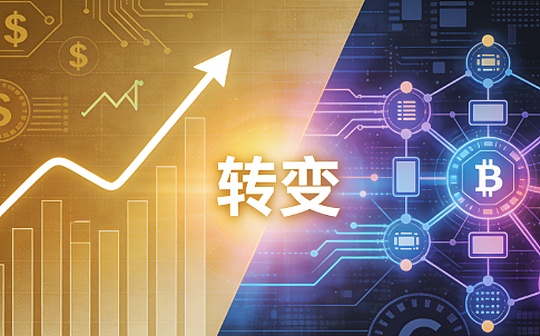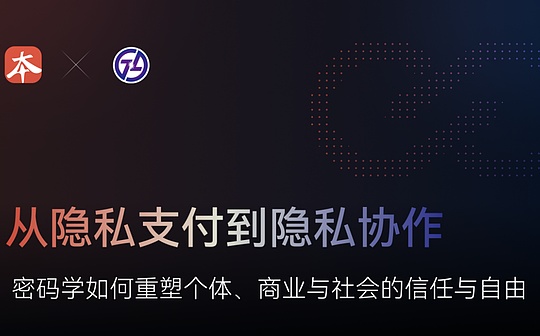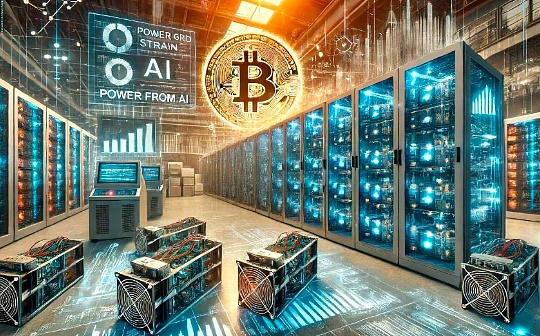
Source: Galaxy; Compilation: Baishui, Bitchain Vision
summary
-
Bitcoin miners with large-scale land, cooling water, dark fiber, reliable power, skilled labor, power approval and critical long-term delivery cycle infrastructure components are well positioned to meet the demands of the rapidly growing AI/HPC data center marketto increase the value of its assets.
Goldman Sachs Research predicts that by 2030, the U.S. data center demand will reach 45 GW, with electricity demand growing at a CAGR of 15% between 2023 and 2030, driven by AI.
-
JPMorgan Chase expects hyperscale AI capital expenditure to reach $370 billion by 2038, an increase of 127% from the expected AI capital expenditure in 2024.
-
Connection requests for facilities ranging from 300 MW to 1,000 MW or above have increased dramatically, which puts pressure on the local grid’s ability to transport power at such a fast speed, resulting in an extension of interconnection and construction time of 2-4 years.
-
Traditional data centers do not have high power capacity and cannot support high-density computing operations.Once the server rack had a maximum power of 40 kW per rack, it now needs to support over 132 kW per rack, which is required for cutting-edge systems such as the GB200 NVL72.
-
Predictability of cash flow, active financing markets, and significant valuation upside in AI/HPC operations make this opportunity attractive and value-added potential for miners with the right assets.
-
Miners can unlock huge value by transitioning to the AI/HPC market, arbitrage their 6-12x EV/EBITDA valuation with the typical 20-25x multiples of current leading data center operators.
Preface
The rise of artificial intelligence (AI) is creating unprecedented demand for high-capacity computing (HPC) facilities.This surge has led to massive investments in new data center capacity by hyperscale enterprises.However, due to limited power capacity, the construction time of new facilities has been extended to 2-4 years, and traditional data centers have difficulty meeting these needs.
Bitcoin miners have a unique advantage to take advantage of this market opportunity, and they have acquired the key components needed for large-scale power infrastructure and data center operations.While not all mining facilities can be converted into AI data centers due to specific requirements for cooling, networking and redundant systems, those with the right assets and expertise will be able to get high cash flow margins and huge estimates from AI/HPC operationsBenefit from the potential of value.The report examines the current landscape of traditional data centers and highlights specific barriers to meeting AI computing needs.The report then analyzes why certain types of Bitcoin miners can fill this gap well and explores future trends at the intersection of Bitcoin mining and AI infrastructure.
What are the opportunities for AI data centers?
AI flourished in 2024, thanks to the widespread adoption of generative AI (GenAI) technology.According to Pitchbook,More than 100,000 transactions have invested more than $680 billion in AI and machine learning startups since 2016 and $120 billion in 2024 alone.
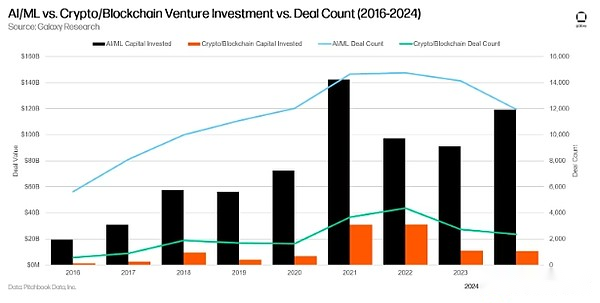
The surge in artificial intelligence and high-performance computing (HPC) is creating huge demand for data center capacity.Data centers are critical to the operation of AI/HP computing, which provides the infrastructure and power needed for GPU-intensive computing.New AI applications such as large language models (LLMs) are particularly power-consuming.The IEA said a single ChatGPT query requires 2.9 watt hours of power, while Google search only requires 0.3 watt hours of power.
The emergence of emerging energy-intensive AI/HPC businesses in the United States has driven the growth of demand for data centers.Goldman Sachs Research estimates that by 2024, U.S. data center demand will reach 21 GW (a 31% year-on-year increase).For reference, the U.S. data center demand growth is estimated at a CAGR of 15.8% in 2022-2033.Based on a significant year-on-year increase in data center demand in 2024, Goldman Sachs Research expects U.S. data center demand to increase to 45 GW by 2030.By 2030, U.S. data centers will consume 45 GW of electricity, accounting for 8% of the total U.S. electricity capacity.

Market opportunities in U.S. data centers will be supported by increased investment in AI infrastructure by hyperscale enterprises, such as Google Cloud and AWS, which can quickly scale data center capacity to serve other enterprise customers.These hyperscale enterprises are committed to investing more than $100 billion in AI data centers over the next 10 years to cope with growing data center demand.JPMorgan Asset Management estimates thatBy the end of 2024, $163 billion will be invested in expanding hyperscale enterprise operations, a year-on-year increase of 28%.Report forecast,In 2038, AI capital expenditure for hyperscale enterprises will reach $370 billion, an increase of 127% from the estimated AI capital expenditure in 2024.
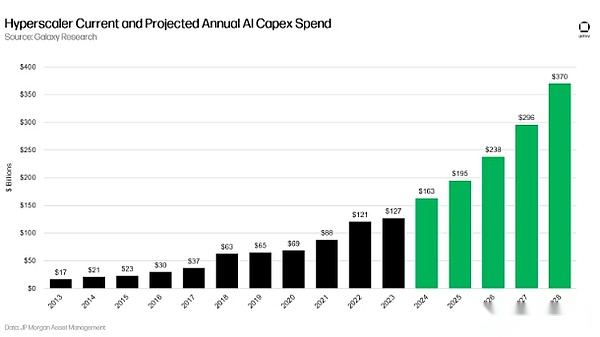
Current and expected growth in AI and HPC technologies is changing the data center landscape.With the increasing processing demand, hyperscale data centers and data centers are gradually evolving from traditional computing facilities to advanced AI infrastructure centers.These facilities are becoming the infrastructure to drive breakthrough technologies such as autonomous vehicles, advanced medical research and next-generation AI applications.The future of digital innovation will largely depend on the continued development and expansion of these critical computing facilities, marking a new era of technological infrastructure.
Current data center market overview
The current data center market consists of multiple public and private enterprises that jointly manage a large number of data centers.Well-known companies in this field include Digital Realty, Equinix, Vantage, EdgeConnex and QTS, among others.According to CBRE, the largest data center region in the U.S. is currently in Northern Virginia, but growth is very rapid in all regions, resulting in vacancy rates at an all-time lowest level.
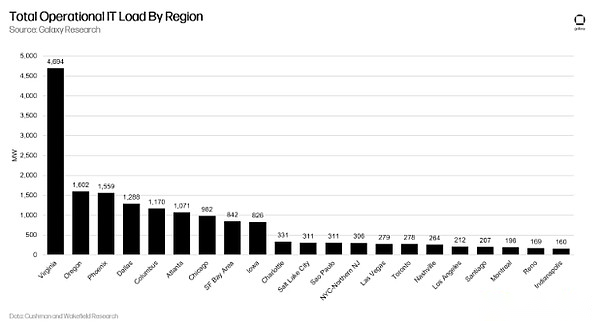
Data centers are the backbone of many different industries, supporting everything from streaming services such as Netflix to cloud computing, artificial intelligence and numerous other applications.However, not all data centers are the same.Each data center can be customized to specific features and can be classified into different categories including hyperscale, edge, cloud and enterprise data centers.Data centers are getting bigger and bigger in size and power density are getting higher and higher.Competition to provide infrastructure for rapidly expanding industries such as AI has led to an arms race among hyperscale enterprises to accelerate the expansion of data center capacity.
Barriers faced by traditional data centers in meeting AI needs
Traditional data center providers serving the non-AI industry often use smaller, geographically distributed combinations of data centers, many of which were originally built for low-density applications.Over the past decade, traditional data centers have consumed relatively low energy.Although Digital Realty ($62 billion in market capitalization) and Equinix ($94 billion in market capitalization) are the two largest data center companies in the world, they mainly operate smaller data centers.For example, Digital Realty’s data centers typically range from 0.5 MW to 40 MW per facility.Similarly, Equinix’s xScale program consists of a global network of data centers with a total operating capacity of only 292 MW of 20 facilities (Equinix Investors’ Third Quarter 2024, November 8, 2024).In contrast, some mining businesses can obtain considerable energy capacity at a single site.
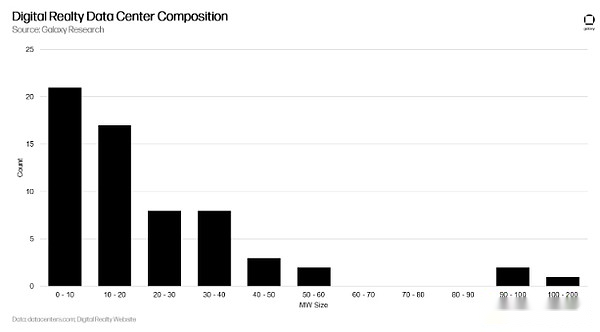
Historically, operators have little incentive to scale up quickly because streaming services, telecommunications, data storage and many cloud applications have limited computing density.However, with advances in artificial intelligence and the increasing complexity of these algorithms, data centers now have to use the latest generation of GPUs and run state-of-the-art facilities at scale to optimize training execution.
The increase in scale is due to advances in GPU computing power and the advantages of parallel computing, allowing data centers to build larger clusters with greater computing power.Parallel computing allows the workload to be seamlessly distributed on other GPUs, thereby scaling efficiently by adding more units.Crucially, large clusters of a single site reduce latency between GPUs, thereby improving performance in parallel computing.This advantage makes a single 200MW cluster much more efficient in AI training than four geographicly distributed 50MW clusters, because low latency communication between GPUs is critical to maximizing computing efficiency.Therefore, hyperscale enterprises prioritize a single location that can obtain high power capacity to meet the needs of advanced AI workloads.
Currently, this capacity is in short supply and many traditional facilities struggle to meet the large amount of energy needs required for modern AI/HPC workloads.Old facilities cannot be easily remodeled due to factors such as network, cooling and rack density requirements between low and high computing use cases.
Today, hyperscale enterprises need data centers with higher energy capacity to support the training of their high-energy models, such as large language models.According to a December 2020 article by Uptime Institute, the average rack density for that year was 8.4 kW/rack, excluding high-performance outliers of 30+ kW/rack.Once the server racks of these data centers had a maximum power of 40 kW per rack, they now need to support more than 132 kW per rack, which is the power required for cutting-edge systems such as NVIDIA’s GB200 NVL72, which has increased in just a few years.More than triple.Industry experts predict that increased computing density and Moore’s Law may push server rack power demand to unprecedented levels.
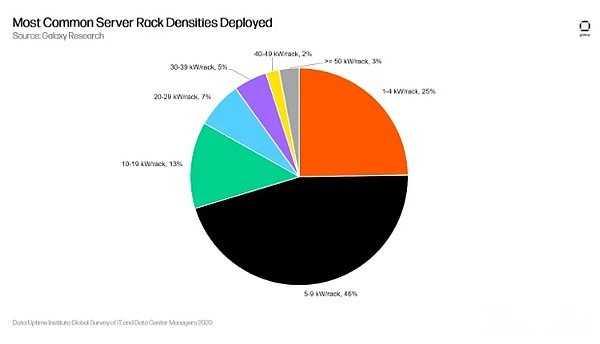
As a result, traditional data center operators have shifted their focus to greenfield development to accommodate the next generation of AI/HPC dedicated data centers, which will take years to review and build energy.According to a recent U.S. Department of Energy’s report, connection requests for facilities ranging from 300 MW to 1,000 MW or more have increased dramatically, which puts pressure on the local grid’s ability to deliver power at such a fast speed, leading to interconnection and constructionThe time is extended by 2-4 years.
Hyperscale data center operators are now aiming to build the largest GPU clusters that can be used to train AI/HPC models, and several companies are targeting gigaW data centers to accommodate hundreds of thousands of next-generation GPUs.While hyperscale data center operators are building their own data centers, they still rely heavily on third-party vendors with mature power capabilities to speed up time to power GPUs.However, only a few existing data centers are able to handle such huge power demands and high rack energy density.This shortage is largely due to the lack of expectations for the rapid growth in demand for data centers.
Why Bitcoin Miners Can Fill Key Voids
Bitcoin miners have large-scale, power-ready facilities, so they are able to meet the energy needs of super-large miners.For years, miners have been looking for places with sufficient energy and affordable prices and ensuring a large amount of power capacity is available in a single location, as well as long-term infrastructure projects such as substation components and medium and high voltage equipment.Some mining sites already have power readiness, which solves one of the biggest constraints faced by super-large miners: access to reliable large-scale electricity.
By entering these power-ready bitcoin mining sites, hyperscale miners can bypass the long process of ensuring energy availability and focus on remodeling and customizing infrastructure to meet their specific needs.Many miners control hundreds of megawatts of sites, and few traditional data center operators can get this scale in a single location.Several large mining companies have established access to industrial-scale power infrastructure, ensuring energy pipelines with capacity exceeding 2 gigawatts (GW), allowing miners to benefit from the growth in power capacity demand.Despite significant differences between traditional Bitcoin mines and AI data centers, miners have valuable experience in large-scale construction and data center management, often with established electrical, mechanical, facility and security teams.These expertise can further simplify the transition to hyperscale enterprises seeking to expand rapidly.
Only some miners can benefit from artificial intelligence
Not all miners can take advantage of AI/HPC opportunities.To build a data center that is suitable for AI/HPC, several key factors must be met, including access to large-scale land, cooling water, dark fiber, reliable electricity, and skilled labor.Unfortunately, even if these conditions are met, companies that have not yet obtained the necessary approval (i.e., power capacity, land and zoning) or have not yet owned critical long-term infrastructure components will experience obstacles and delays in the development process.
Another key reason why not all Bitcoin miners can take advantage of AI/HPC opportunities is that miners’ existing infrastructure cannot be directly transferred or applied to AI data centers due to differences in design and operational requirements.While there are some similarities between critical electrical infrastructures, including high-voltage substation components and distribution systems, AI data centers have specific requirements that require meticulous expertise and a skilled workforce.
The complexity of AI data centers increases almost all operations, including machinery, cooling and network systems, making it a daunting task to transform Bitcoin mining facilities into AI/HPC data centers.Below, we outline some of the major upgrades miners need to transform their existing facilities into an AI data center:
1. Network infrastructure:
AI/HPC workloads require high-speed, low-latency connections between data center GPUs.Therefore, the internal network structure of AI/HPC workloads is much more complex than mining because GPUs constantly communicate with each other.The key to successful AI operations is to develop the best network backbone to ensure workloads are executed quickly.In addition, connections to dark fiber must be established from the site and the delay requirements are met, which are not required for mining sites.
2. Cooling system:
Miners use a variety of cooling designs, including air-cooled, water-cooled and immersive cooling systems.Cooling is mainly focused on the actual machine itself, with less attention to supporting infrastructure.AI data centers, on the other hand, will require more advanced cooling solutions, such as liquid cooling directly to the chip to cool the latest generation of power-intensive NVIDIA servers, and combine additional air-cooling systems to support network and mechanical infrastructure.
3. Redundancy:
Compared with Bitcoin mining data centers, artificial intelligence data centers have stricter requirements on redundancy.Mining operations are inherently flexible and therefore do not require powerful backup power generation facilities.On the other hand, AI data centers usually use at least N+1 redundancy throughout their operations, while more mission-critical components such as core networks and storage components require a higher degree of redundancy to ensure uninterrupted operation., or at least correctly cache and check data in the event of a device failure.This means that for every important infrastructure (such as cooling equipment), there must be a backup (N+1 redundancy).For example, when maintaining a cooling device, an additional device must be provided to maintain continuous operation.This level of redundancy is rarely seen in mining facilities without such uptime requirements.
4. Dimension redesign:
AI data centers use rack servers, which is very different from the shoe box ASICs used in Bitcoin mining.To accommodate AI hardware, the internal physical infrastructure of the facility needs to be completely redesigned to support rack-mounted systems and their specific cooling, networking and electrical needs.
5. Other differences:
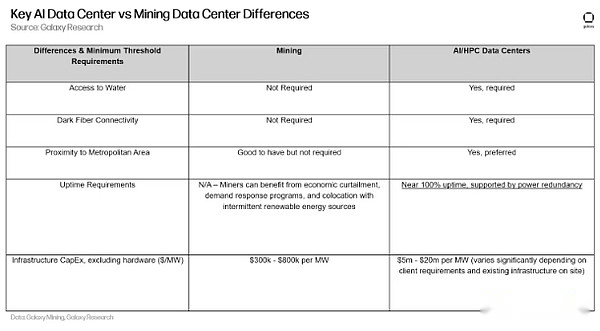
Overall, these factors suggest thatRenovating mining facilities to meet the requirements of AI/HPC data centers is a design and engineering challenge.Enhanced infrastructure requirements also result in a significant increase in capital expenditure costs for AI/HPC data centers relative to the cost of Bitcoin mining construction.
Mining tools that can take advantage of the needs of AI data centers have upward potential
While miners may have the right infrastructure and location, transitioning to AI/HPC operations requires more than physical assets – it requires expertise, different technology stacks and new business models.Those with experienced management teams and able to successfully build AI/HPC operations have a huge opportunity to bring huge incremental value to their company.Here are some key advantages that can add value to companies that choose to allocate their power and data center resources from Bitcoin mining to AI/HPC:
-
High cash flow margins and predictability:AI/HPC data center operations, especially hosting/customization models, have long-term contracts and often agreed on fixed and recurring cash flows before data center construction begins.These are predictable and profitable cash flows, often in partnership with reputable counterparties, where data center operators can pass on most of the costs to tenants, including energy and operating expenses (depending on the lease structure).
-
Diversification of cash flow:Not only is revenue more predictable than Bitcoin mining, it is also not related to the cryptocurrency market, which balances the revenue profile of companies at riskier levels in the turbulent cryptocurrency market.In a Bitcoin bear market, this can enhance financial stability, allowing miners to continue raising cash through equity or debt without overdilution or interest burden.
-
Deep capital markets can help expand operations:Although infrastructure is much more expensive than Bitcoin mining, underwriting investment is more direct due to the predictability of cash flow, opening up new sources of debt and equity capital for data center projects.Many companies, including private equity companies, infrastructure investments, pension funds, life insurance companies, etc. are eager to get involved in the data center field to earn profits.Data center operators that have leased with reputable counterparties can lease the lease and raise a lot of project financing to build the data center.
-
According to Newmark’s Annual Overview of Data Center Markets 2023, the amount of term debt financing hit an all-time high and did not slow down, with $18 billion in development financing underwritten in the first quarter of 2024 alone.Interest rates are also reasonable, with Newmark’s interest rate range of about 2.25% – 4.50% of the SOFR, depending on the lender.
-
Huge valuation appreciation potential:Once the assets are established and stabilized, there is also a huge valuation difference between mining and AI/HPC, which makes AI/HPC a very attractive opportunity.Bitcoin miners have historical transaction prices in the range of 6-12 times EV/EBITDA multiples, while some of the world’s largest data center operators are valued at 20-25 times EV/EBITDA.This is reasonable given the industry’s high profit margins, growth trajectory, predictable cash flow, and reduced market volatility compared to cryptocurrencies.To further understand the scale of the current differences, the total EV of hybrid mining/AI companies is 23% of the Digital Realty EV, although the total potential MW capacity is 3.5 times that of the latter.

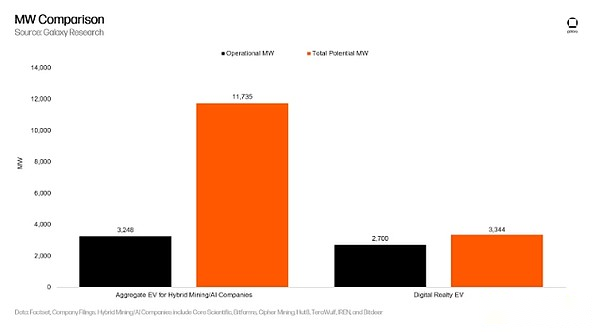
Therefore, cash flow predictability, active financing markets and significant valuation upside potential make AI/HPC opportunities extremely attractive and value-added for mining tools with the right assets.These miners are expected to make significant progress in the traditional data center market and become one of the largest operators in the industry.
The prospects of Bitcoin mining
AI/HPC has attracted much attention in the past few months, but we still expect the hash rate and growth of the Bitcoin mining network to continue to rise.The growth of mining is synchronized with the growth of AI/HPC.Rising Bitcoin prices have boosted miners’ profitability and mining may become more profitable if prices continue to rise and exceed network difficulty.butWith the rise of Bitcoin and AI/HPC, what will the future mining landscape be like?Below we outline some of the main trends in the integration of AI/HPC with Bitcoin mining that may arise in the foreseeable future:
Miners maximize the value of electronics:
Most Bitcoin miners always prioritize maximizing their energy use value.Currently, AI data centers are the most profitable avenue for those with adaptable sites.Given the value growth of AI/HPC sites, mining sites that can be converted to AI/HPC data centers are likely to follow this path to maximize shareholder value.However, this does not necessarily mean the shortcomings of Bitcoin miners.We still expect network hash rates to grow, but it will be slower than when no major U.S. miners convert sites to AI/HPC data centers.These transformations benefit miners who stay on the network by eliminating the competing hash rate.
Bitcoin mining is the driving force for monetizing idle power:
With the increasing prominence of AI/High Performance Computing (AI/HPC), we expect miners to focus further on deploying their capacity in more remote areas, as hyperscale enterprises have available for AI/High Performance Computing in more developed marketslarge site, so bids are higher than miners.Bitcoin mining requires no permission, is not restricted by location, and is flexible, making it one of the best ways to leverage idle power generation capabilities.
We expect a larger portion of Bitcoin mining to be pushed to the border to monetize idle power capacity – especially in remote areas of the United States and international emerging markets such as Ethiopia and Paraguay, which have rich cheap excess energy.
Bitcoin Mining As a Strategic Bridge for Infrastructure Investment and AI/HPC Options
Additionally, as different regions of the United States work to build transmission infrastructure and fiber optic connections, Bitcoin mining can act as a bridge to underwrite larger capacity energy infrastructure projects such as substations and power plant construction, even if there is no immediate or clear opportunity to exploitThe same is true for AI/HPC capacity.By using Bitcoin mining for opportunistic real estate and power generation-related investments, investors can earn returns while awaiting other long-term energy use cases, positioning them as an attractive strategy for infrastructure growth and investment.
For miners who cannot convert to AI/HPC data centers, Bitcoin mines can still operate as long-term profitable businesses.Several miners purchased heavy load facilities without existing AI/HPC tenants and also invested in sites at different stages of development.As we outlined earlier, some of these sites may not have the best features required by AI/HPC, but are still useful for Bitcoin mining.Other miners do not have teams or internal expertise to sign up with major offenders and undertake challenging engineering and large-scale construction projects.The hope of miners seeking to maximize value is to lock in an AI customer, but these miners still have the option to build a profitable BTC mining business when AI/HPC opportunities are not possible.
Emerging synergies between AI/HPC data centers and mining
ASIC manufacturers such as Bitmain have begun developing ASICs with similar shapes to GPUs for data center racks.Further coordination of ASIC form factor with next-generation GPU form factor will allow data centers to monetize their underutilized server racks by installing server-sized miners in free rack space, which willHelps simplify the process of transforming data centers for AI/HPC.Going forward, miners may be more willing to buy these machines because they remain flexible in data center design and can help miners switch to AI/HPC more easily if there is a higher value opportunity.
As AI/HPC data center capacity grows, so does their impact on the power grid.While these data centers must be online almost always, this does not necessarily mean that the total energy consumption is constant.In fact, the load curves trained by AI/HPC can be very unstable because more power is consumed during intensive computing execution and less power is consumed during checkpoints.Checkpoint frequencies vary, and the process can take several minutes to several dozen minutes depending on the infrastructure deployed and the size of the model.As the model scales, more data needs to be stored, thereby increasing the time it takes to save all the data.
Similarly, for AI/HPC inference workloads, the load profile is expected to be closely integrated with customer requirements, as each model query is processed directly within the data center.Initially, these profiles may show a lot of volatility as model demand fluctuates.However, over time, with widespread adoption of specific models, loads may become more predictable, with demand peaking during the day and demand dropping at night.This daily load cycle provides ideal opportunities for Bitcoin mining, as mining operations can be dynamically expanded or narrowed to complement the energy demands of fluctuating AI reasoning processes.
therefore,In the future, Bitcoin mining can be used as a load balancing mechanism, which will increase when the load is low and decrease when the AI load is restored.Tenants may not need to use all GPU capacity yet, allowing miners to speed up.
The benefits are obvious for data center operators because they are able to get more value from the capacity that is online, which for tenants provides a level of load stability for the data center and the entire grid.As data center clusters grow in size, power consumption and impact on the power grid will be under increasingly scrutiny, ensuring load stability will be crucial.
Moving MW to AI/HPC should slow the growth rate of hash rate
Miners entering AI/HPC operations are actively shifting capacity that could have been used for Bitcoin mining, which should slow the growth rate of network hashrates.This is especially important considering the potential bull market for Bitcoin, as the rise in Bitcoin price will not lead to an equal and offset growth in the network hash rate, which will drive up the hash rate.That being said, we still expect network hash rates to rise as more efficient mining machines are put into use, whether to replace older generation machines or to make new net investments at sites that are not conducive to the AI/HPC business.
Summarize
Data center demand in the U.S. is likely to surge at an unprecedented rate, with a year-on-year growth of 31% in 2024 alone.These forecasts also suggest that U.S. data center capacity will more than double in the next five years, jumping from the current 21 GW data center capacity to an estimated 45 GW.This explosive growth, coupled with the hundreds of billions of dollars committed by hyperscale providers over the next 5-10 years, creates attractive opportunities for businesses that can provide two key resources: abundant cheap energy and the ability toStrong infrastructure that supports AI and HPC operations.
The current AI and HPC boom has exposed a key weakness in traditional data centers that they cannot transform existing facilities to meet the strong power needs of modern AI workloads.This gap in the market creates significant opportunities for Bitcoin mining businesses that already have something AI/HPC companies desperately need: large sites with accelerated power-on plans.The choice of hyperscale providers is limited and cannot expand their business in a timely manner to meet the explosive needs of their AI/HPC business.Bitcoin miners are becoming a reasonable and viable option for hyperscale enterprises to expand their business and stay competitive in a growing market.However, this generational opportunity for Bitcoin miners is still selective.Only a small percentage of Bitcoin mining operations have the necessary infrastructure and capabilities to successfully support the demanding requirements of modern AI/HPC workloads.Miners who own these scarce assets and seek to maximize their value will turn to AI/HPC data centers.
While some critics argue that diversifying Bitcoin miners to AI/HPC services may undermine cybersecurity by reducing computing power dedicated to mining blocks, this shift may actually benefit the wider mining ecosystem.Miners who cannot meet the needs of AI/HPC sites can gain higher profitability from the increase in hash prices.As more and more miners go offline and Bitcoin prices rise, the rise in hash prices will significantly increase the profit margins of all Bitcoin miners.With Bitcoin prices rising as much as 143% so far this year and the new pro-Bitcoin president taking over the White House, Bitcoin mining in the U.S. is expected to enter its strongest era to date.
The intersection of cryptocurrency and artificial intelligence is arguably one of the hottest cryptocurrency sectors of 2024.As of December 2024, the total market capitalization of cryptocurrency projects that use liquid tokens to build AI projects was approximately $33 billion.In addition, Galaxy Research estimates thatIn 2024, more than $382 million in venture capital has been allocated to early-stage crypto AI startups.While most crypto AI projects lack product market fit, the intersection of Bitcoin mining and AI/High Performance Computing business growth is evident.Bitcoin mining enters the AI field to stand out from other overlapping areas in these two fields because it has the potential to supply energy, the most important component of the AI/HP business at scale.Thus, Bitcoin miners holding AI/HP convertible assets may be one of the only pure and scalable cryptocurrency x AI investments in the industry today.

